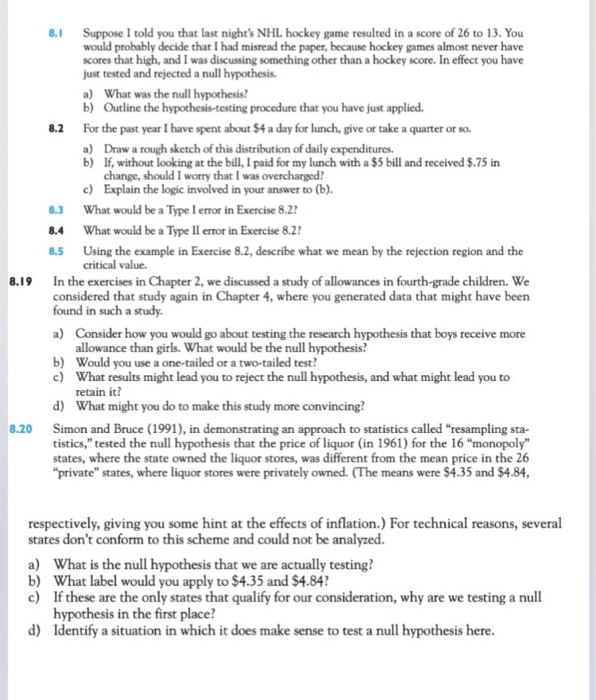Answered step by step
Verified Expert Solution
Question
1 Approved Answer
8.19 8.20 8.1 a) What was the null hypothesis? b) Outline the hypothesis-testing procedure that you have just applied. 8.2 For the past year

8.19 8.20 8.1 a) What was the null hypothesis? b) Outline the hypothesis-testing procedure that you have just applied. 8.2 For the past year I have spent about $4 a day for lunch, give or take a quarter or so. 8.3 8.4 8.5 Suppose I told you that last night's NHL hockey game resulted in a score of 26 to 13. You would probably decide that I had misread the paper, because hockey games almost never have scores that high, and I was discussing something other than a hockey score. In effect you have just tested and rejected a null hypothesis. b) c) a) Draw a rough sketch of this distribution of daily expenditures. b) If, without looking at the bill, I paid for my lunch with a $5 bill and received $.75 in change, should I worry that I was overcharged? c) Explain the logic involved in your answer to (b). What would be a Type I error in Exercise 8.2? What would be a Type II error in Exercise 8.2? Using the example in Exercise 8.2, describe what we mean by the rejection region and the critical value. In the exercises in Chapter 2, we discussed a study of allowances in fourth-grade children. We considered that study again in Chapter 4, where you generated data that might have been found in such a study. a) Consider how you would go about testing the research hypothesis that boys receive more allowance than girls. What would be the null hypothesis? Would you use a one-tailed or a two-tailed test? What results might lead you to reject the null hypothesis, and what might lead you to retain it? What might you do to make this study more convincing? d) Simon and Bruce (1991), in demonstrating an approach to statistics called "resampling sta- tistics," tested the null hypothesis that the price of liquor (in 1961) for the 16 "monopoly" states, where the state owned the liquor stores, was different from the mean price in the 26 "private" states, where liquor stores were privately owned. (The means were $4.35 and $4.84, respectively, giving you some hint at the effects of inflation.) For technical reasons, several states don't conform to this scheme and could not be analyzed. a) What is the null hypothesis that we are actually testing? b) What label would you apply to $4.35 and $4.84? c) If these are the only states that qualify for our consideration, why are we testing a null hypothesis in the first place? d) Identify a situation in which it does make sense to test a null hypothesis here.
Step by Step Solution
★★★★★
3.43 Rating (159 Votes )
There are 3 Steps involved in it
Step: 1
81 Null Hypothesis and Testing Procedure a Null Hypothesis The null hypothesis H0 in this scenario is that the score you reported 26 to 13 is a valid representation of a typical NHL hockey game b Hypo...
Get Instant Access to Expert-Tailored Solutions
See step-by-step solutions with expert insights and AI powered tools for academic success
Step: 2

Step: 3

Ace Your Homework with AI
Get the answers you need in no time with our AI-driven, step-by-step assistance
Get Started


